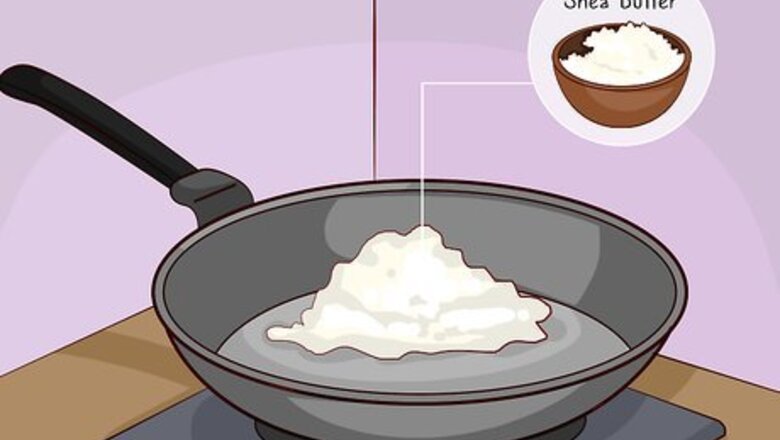
views
X
Expert Source
Nini Efia YangMakeup Artist
Expert Interview. 27 August 2019.
Coconut oil, shea butter, honey, and castor oil can all be used in various proportions to make a solid, hydrating lip gloss. Try a simple honey lip balm with coconut oil or shea butter, for instance. You can also make your lip balm from gelatin powder to give it structure or make a moisturizing gloss from a blend of oils and butters.
Making a Simple Honey Lip Balm

Add 1 tablespoon (15 mL) of shea butter or coconut oil to a small pan. You can double the amount if you want to make multiple lip balms. You can also place this in a double boiler, which is just a heat-safe bowl over a pot that has boiling water in it. Don't allow the bottom of the bowl to touch the boiling water. The double boiler will allow you to heat the oil or butter more slowly so it doesn't burn. Another option is to put this in a small microwave-safe bowl to heat in the microwave. Shea butter is a better general moisturizer, since it has vitamin E in it. However, coconut oil is also hydrating.
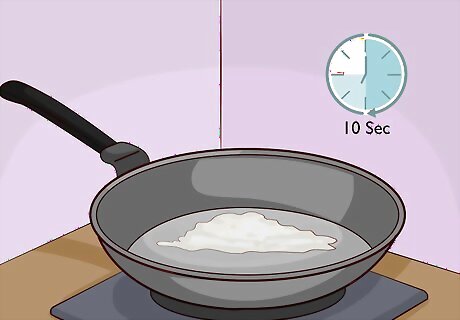
Heat the shea butter on the lowest setting. Because you're using such a small amount of shea butter, it can burn easily. Keep an eye on it, and set the burner on the lowest setting you can. Don't let it bubble! It's heated enough when the shea butter or coconut oil is melted. If you're heating it in the microwave, start with 10 seconds and check on it. Stir it and heat it in 5-second increments after that.

Add in 1 tablespoon (15 mL) of raw honey and 4-5 drops of essential oil. Take the shea butter off the heat and let it cool for 2-3 minutes. Stir in the honey and essential oil until they're well blended. Try peppermint, rose, or a citrus essential oil. If you don't want to use honey, you can substitute castor oil, which is a vegan ingredient. Use castor oil in the same proportions as the honey. Honey draws moisture to your lips and helps exfoliate them, while castor oil is good for hydration and dealing with chapped lips. Instead of essential oil, try adding in a few dashes of ground cinnamon.
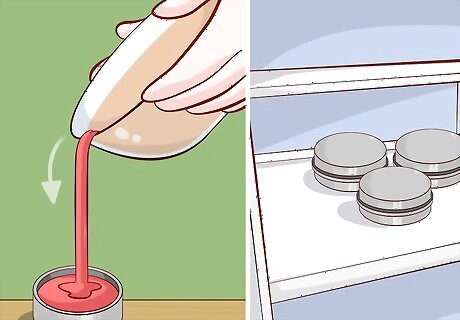
Pour the lip balm into a container to cool. Opt for an old lip balm container or any small container you have. You can use an old mint tin, a small baby food jar, or even an old (clean) pill bottle. Leave it overnight to cool and solidify. You can store this lip balm at room temperature for several months.
Creating Fruity Gelatin Lip Balm

Warm up 2 tablespoons (30 mL) of coconut oil in the microwave. Start with 15 seconds. If that doesn't melt the oil, heat it at 5-second intervals. You need the coconut oil hot enough to liquefy and activate the gelatin. It won't mix well if it's still in its solid form. You can also use equal parts of coconut oil and petroleum jelly. You may need to stir it a bit to make sure it's evenly melted. Coconut oil is hydrating, while petroleum jelly helps seal in moisture.
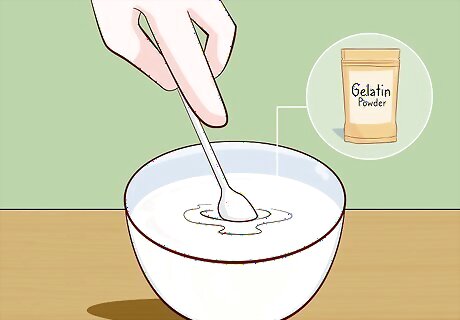
Mix in 2 teaspoons (about 6 grams) of your favorite gelatin powder. Mix it in while the oil is hot, making sure to stir it thoroughly. The heat will help activate the gelatin so the lip balm will set up properly. You can use any flavor you like, but keep in mind it will also tint the lip balm. Try raspberry, cherry, or strawberry for a pink-red color. You can also go a little crazy with grape for a purple lip balm or blue raspberry for a bright blue color. For a colorless balm, try unflavored gelatin. You can use sugar-free gelatin, too, but you may need to use a little less powder. Experiment to see what works! Gelatin mainly helps set the lip balm, though the protein in gelatin may be beneficial.
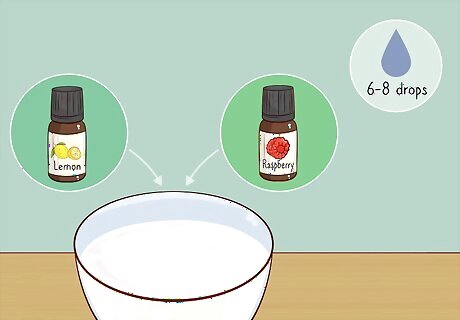
Add in 6-8 drops of an essential oil in a complementary flavor. This step is optional, but it can add some zing to your lip balm. For instance, try lemon or mint oil with raspberry, grapefruit oil with cherry, or orange oil with grape gelatin. Mix the oil in. Most citrus essential oils have antioxidant and antibacterial properties.

Pour the mixture into a small container to set. You can use old lip balm tubes or any small container, such as a clean baby food jar. Put it in the refrigerator to cool for 2-3 hours if you're in a hurry, or you can just let it sit overnight. You can use it when it's cooled down completely and solidified a bit. If you want to use multiple lip balm tubes, use a rubber band to tie them together. That will make it easier to pour the lip balm into the tubes. This should keep several months at room temperature since it doesn't have water in it. However, if it smells off or has mold, throw it out.
Mixing a Hydrating Lip Balm
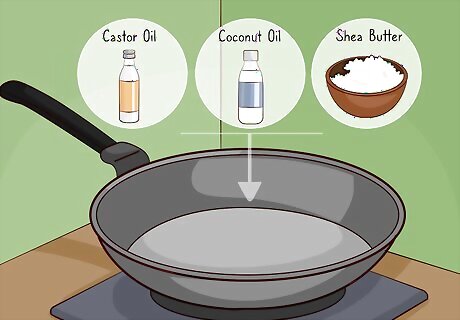
Add castor oil, shea butter, and coconut oil to a small pan. Pour in 1 tablespoon (15 mL) each of castor oil and shea butter. Measure out 2 tablespoons (30 mL) of coconut oil, and add that to the pan, too. If you want, you can substitute petroleum jelly for the castor oil in the same proportion. Petroleum jelly seals in moisture. Castor oil soothes chapped lips and hydrates. Both shea butter and coconut oil hydrate, but shea butter has vitamin E, too, which is good for your skin. You can also leave out the shea butter if you'd like. Try adding more coconut oil. You can also heat these in the microwave; if you'd like to, use a small microwave-safe bowl.

Place the pan over low heat to melt the oils together. As the oils warm up, stir them occasionally to distribute the heat evenly. Once the coconut oil and shea butter have melted and the oils are all incorporated, take the pan off the heat. If you heat it in the microwave, start with 15-20 seconds and check on it. Heat it up in 5-second increments until the oils are melted and mixed together.

Pour in a few drops of the essential oil of your choice after you take the oils off the heat. Try 10-15 drops of citrus essential oil, such as grapefruit, lemon, or orange for a summery lip balm. Alternatively, add peppermint for a cooling lip balm. If you like floral flavors, use lavender or rose oil. Citrus essential oils have antioxidant and antibacterial properties. Clove or cinnamon are also good options, but you should start with just a few drops. They can get overpowering very quickly. They have a warming effect on your lips. If you don't have any essential oils, try sprinkling in 1/4 a packet of a drink powder mix, such as Kool-Aid or Crystal Light, which will add color and flavor. For a natural tint, add 1/4 teaspoon (1.5 grams) of beet root powder.

Add the lip balm to a small container to cool. Stick it in an old lip balm container, a small mint tin, or anything else you have on hand. Let it cool overnight or stick it in the fridge to cool faster. It's ready when the lip balm has cooled and solidified. This should last several months at room temperature.
















Comments
0 comment